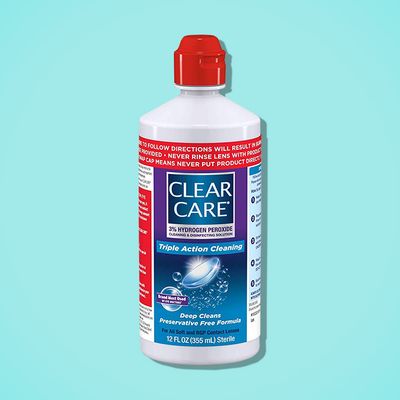
I actually heard Clear Care before I ever saw it. Not heard about it, but literally heard it: I was in college, sitting in a hall mate’s dorm room, when a fizzing sound — like when you drop some Mentos into a can of Coke — cut through the freshman-floor gossip. When I asked what the noise was, my hall mate directed my attention to a tiny contraption filled with a frothing liquid. She was just cleaning her contacts, she explained.
While I had been wearing glasses since the third grade, I only started wearing contact lenses every day in college. A big reason why it took so long was because I was seriously skeeved out by the filmy concave pieces of silicone that never felt clean no matter how much Biotrue I squirted on them. That and the fact that even the contact lenses I picked up from a mall optician were expensive. The $150 my six-month supply of two-week lenses cost was an entire paycheck from my on-campus job. It was amid this existential contact-lens crisis that my broke (and brilliant) hall mate let me in on a secret: Clear Care solution cleaned her contacts so thoroughly that she could stretch her prescription out, she promised.
I bought a bottle of it, dutifully rinsed my lenses in the solution for five seconds as Clear Care instructs, then nestled them into the case that comes with the solution for their first Clear Care bath. The next morning, I couldn’t believe how clean my lenses felt — it was as if I had just ripped open a fresh pair. And as they neared the end of their two-week lifespan, I found that they still felt just as fresh as they did on the first day I opened them. It wasn’t until I reached the four-week mark that the lenses started to feel slightly past their prime, and that’s when I finally threw them away.
The magic of Clear Care, I later learned, is hydrogen peroxide — precisely 3 percent of it — and a surfactant called Pluronic 17R4, which removes dirt, germs, and protein buildup much better than regular saline solution. If the idea of dousing hydrogen peroxide on something you put directly onto your cornea sounds a little scary, I get it: It did at first to me, too. But after six hours of bubbling away — and making that distinctive fizzing sound as the hydrogen peroxide and Pluronic 17R4 work to destroy grime — the solution neutralizes and becomes basic saline. Two very, very important notes to prospective users: In order for this neutralization process to occur, Clear Care requires you to use the case that comes with its solution, and says not to shake the case during the six hours it needs to neutralize. If you use another case or do not wait the required six hours — or if, like me, you foolishly travel with the still-fizzing case tumbling around in your Dopp kit — you will feel the pain of chopping a thousand onions when you reapply your lenses. (I learned that lesson the hard way, on a vacation, no less).
In case you need a second opinion: Years later, after I had convinced my brother and several friends to ditch their regular old saline solution for Clear Care, I visited a new optometrist. He asked me what solution I use, and I told him, emphatically, that I use Clear Care. He then nodded sagely. “Don’t mess with the best,” the optometrist said.
The Strategist is designed to surface the most useful, expert recommendations for things to buy across the vast e-commerce landscape. Some of our latest conquests include the best acne treatments, rolling luggage, pillows for side sleepers, natural anxiety remedies, and bath towels. We update links when possible, but note that deals can expire and all prices are subject to change.







